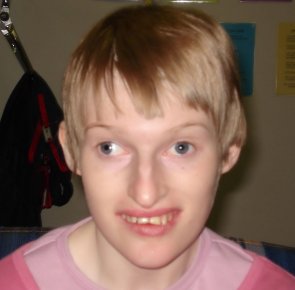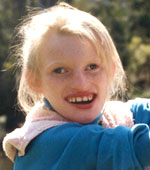Ever seen a little child with a flat head, walking like a puppet and laughing wildly? You are likely to have seen a Angelman Syndrome sufferer. Read on to know all about this peculiar syndrome that is also known as ‘Happy Puppet Syndrome’.
About Angelman Syndrome
Page Contents
It is a rare neurological disease that is characterized by jerky movements and abnormal behavior. 1 in every 12,000 or 20,000 people are said to be affected by this disorder. It is a very rare condition that is often associated with other psychological and neurological disorders. There is also an Angelman Syndrome Foundation.
History of Angelman Syndrome
The disorder was first described in 1965 by the British pediatrician Dr. Harold Angelman. Harold was then working in Warrington (formerly in Lancashire). He noted the symptoms of condition in three children. He wrote about the condition in an article titled “Puppet Children”. The title was inspired by the painting “Boy with a puppet” by painter Giovanni Francesco Caroto that Harold saw in the Castelvecchio Museum in Verona, Italy. This has lent the alternate name ‘Happy Puppet Syndrome’ to the disease. The original name Angelman Syndrome credits the doctor himself.
Angelman Syndrome Symptoms
The disorder is characterized by a host of seemingly peculiar symptoms. Some of the notable symptoms of Angelman Syndrome are
- Flat Heads – It is the most visible symptom noted in the physicality of Angelmans Syndrome sufferers. The growth of the head is slow in Angelman children. The head circumference is normal at birth but it is found to be smaller when they are about 2 year old.
- Attention Problems – Sufferers usually have a short attention span.
- Smiling Face – Patients generally have a smiling appearance even without any apparent reason.
- Feeding Problems – Feeding Angelman patients is very difficult, especially young infants aged between 1 and 2 months.
- Jerky Movements – Most of the sufferers jerk their hands and feet. Little children flap their hands in a way that make them look like puppets. Most of them stick their tongue out.
- Wide Teeth – The teeth are spaced wide in the mouth of the Angelman sufferers.
- Hyperactivity – The patients show tremendous energy for the most part of the day. At times, their energetic behavior becomes difficult to control.
- Speech Impairment – Speech problems are pronounced in these patients. The use of words is minimum or completely absent.
- Balance Problems – Most Angelman sufferers cannot balance themselves properly. They move weakly on their limbs.
- Developmental Delay – Affected children grow six to 12 months slower than normal children.
- Seizures – This generally starts in children aged less than 3 years.
Other irregular symptoms, not commonly found in Angelman sufferers, include frequent drooling, irregular eating and sleep-wake patterns, obesity constipation and impaired motor functions.
Angelman Syndrome Causes
Genetics is believed to be primarily responsible for the appearance of this disorder. In most cases, the disease is acquired by heredity. But there are instances when the ailment has been found to appear due to genetic mutation. In Angelman sufferers, the series of genes responsible for the regulation of UBE3A protein are impaired or even absent. Generally a person inherits a copy of the UBE3A gene from both parents. In some areas of the brain only the maternal copy becomes active. If this copy is lost due to a genetic mutation, Angelman Syndrome may occur.
Apart from heredity and genetic mutation, there are a few other unknown causes of Angelman Syndrome. These are noted in 10 to 15 percent of Angelman sufferers. A kind of chromosomal change is believed to be the reason behind the appearance of the disorder in these individuals.
Angelman Syndrome Photos
Angelmans Syndrome is a rare disorder that affects only a few people in the world. We have provided some photographs here that show patients suffering from the disease. Check out these Angelman Syndrome pictures to get a thorough knowledge about this unique disease.

Picture 1 – Angelman Syndrome
Source – blogspot

Picture 2 – Angelman Syndrome
Source – psychnet-uk
Angelman Syndrome Diagnosis
Angelmans Syndrome is not visible during birth. The symptoms are usually evident between 3 and 7 years of age. Naturally, diagnosis of the syndrome is done in children aged between 3 and 7. The diagnosis is based on observation as well as physical tests of the patient. The doctor checks the physical as well as mental developmental progress in the child. The facial appearance, behaviour and physical movements are observed. For a proper diagnosis, a number of tests are conducted. These include:
Abnormal Electroencephalography (EEG) Test – The electrical activity of the brain is recorded and checked for abnormalities.
Cytogenetic Testing – This is done to check any visible rearrangement of the chromosomal structure.
DNA methylation Analysis – This is one of the most important and preliminary genetic tests conducted on an Angelman patient.
Fluorescent In Situ hybridization (FISH) – The deletion of the chromosomal copy is detected through this procedure.
Uniparental Disomy (UPD) – DNA samples from the patient as well as the parents are collected and used for polymorphism testing.
Imprinting Center Analysis – The microdeletions are detected by this method.
UBE3A Sequence Analysis – It is done to check any impairment or absence of the UBE3A genetic copy.
Angelman Syndrome Treatment
As of now, there is no method for complete Angelman Syndrome cure. However, the symptoms of the disorder can be controlled through medication and therapies.
Medications
Angelman Patients are treated with drugs that control their symptoms. As the condition involves epileptic seizures, the sufferers are often provided with anticonvulsant medicines. Melatonin is also provided to let the patients sleep for several hours at a stretch. Generally, these people cannot sleep for more than 5 hours at one time. Mild laxatives are also offered frequently to make their bowel movements regular.
Therapies
Angelman patients suffer from severe speech and movement problems. These can affect their daily lives as well as those around them. There are therapies to help these patients lead a normal life. Communication therapies are provided to help Angelman sufferers overcome their speech problems. There are behavioral and occupational therapies that help the patients control their movements and act in ways that let them live like average persons. Physiotherapy is also used to prevent stiffening of joints in the Angelman people.
Angelmans Syndrome life Expectancy
With a healthy and active lifestyle, people with Angelmans Syndrome can survive as long as a normal person. Generally, the disorder has not been found to have any effect on the life span of sufferers. The Angelman Syndrome life span is not an abnormal one.
Famous people with Angelman Syndrome
James Farrell, the four year old son of Hollywood actor Collin Farrell suffers from this disorder. Other famous Angelmans Syndrome patients include sons of prominent personalities like hockey player Peter McDuffe, baseball pro Dave Henderson and writer Ian Rankin.

Picture 3 – Dave Henderson
Source – hendersonbaseball

Picture 4 – Ian Rankin
Source – smh
Angelman Syndrome Statistics
Check out these startling statistics about Angelmans Syndrome:
- 100% of Angelmans Syndrome patients in the U.S suffer from speech disability.
- 100% Angelmans Syndrome sufferers in the US show developmental delay.
- 20-80% sufferers of the syndrome in the US show tongue thrusting or swallowing disorders.
- 1 to 8 in every 10 Happy Puppet Syndrome sufferers have sleep disorders.
Angelman Syndrome is an incurable disease. But the disorder is not life-threatening and there are many sufferers who lead almost normal lives. If you know someone with this syndrome, you can try medications and therapies to let that person enjoy a happy and healthy life.
References:
http://en.wikipedia.org/wiki/Angelman_syndrome
http://www.medicinenet.com/angelman_syndrome/article.html
http://www.ncbi.nlm.nih.gov/bookshelf/br.fcgi?book=gene&part=angelman
http://www.wrongdiagnosis.com/a/angelman_syndrome/stats.html

This has been a great help!
Thank you
many many thanks for the infomation regarding A.S.im about to start a new job taking care of three A.s clients and what i have learnt so far is bound to help me, again many many thanks. karen.
I want treatment in USA with complete detail for angleman syndrome with all visa formalties
My Baby had Angelman Syndrome,My Daughter Pass awayon June 8th,2010 and I feel that if more doctors take the time to learn the symdrome to help children like my daughter and others it would help alot if you don’t know how to care for a child please send them to a Doctor who can because IT HURT SO MUCH NOT TO HAVE YOUR CHILD AND I AM JUST A MOTHER WHO CARES. HOPE THIS CAN HELP SOMEONE AND GOD BLESS YOU .THANKYOU
Do people with Angelman Syndrome have any sort of problems with there bowel movements?